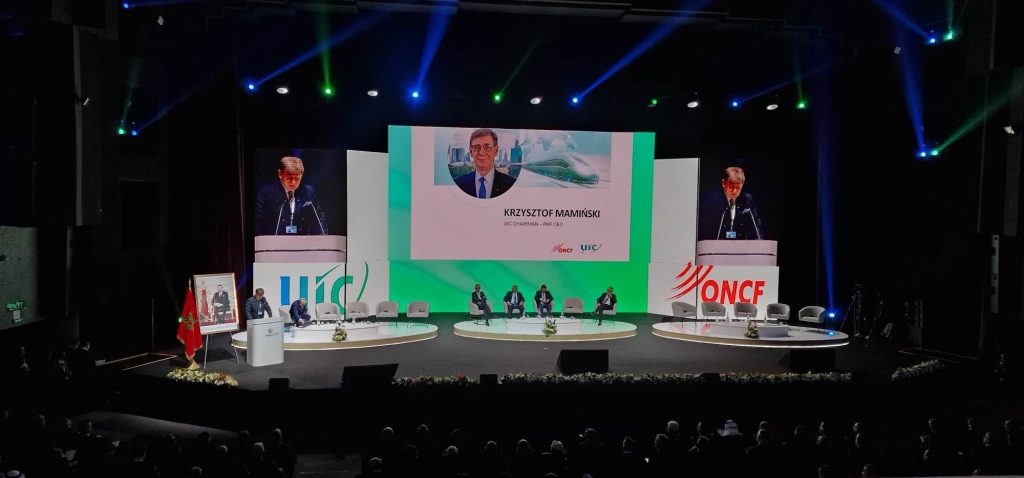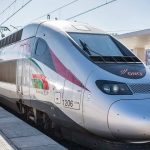 “High-speed railway network is developing very dynamically. The pandemic has not prevented the expansion of high-speed rail network, whose total length has increased from 44,000 km in 2020 to around 59,000 km in 2022, an increase of more than a third. The number of countries making use of high-speed railways is only increasing, as additional countries are in the process of developing projects,” Mr. Krzysztof Mamiński, the UIC Chairman said at the 11th UIC High-Speed Congress taking place on 7-10 March at Palais des Congrès in Marrakech, Morocco.
“High-speed railway network is developing very dynamically. The pandemic has not prevented the expansion of high-speed rail network, whose total length has increased from 44,000 km in 2020 to around 59,000 km in 2022, an increase of more than a third. The number of countries making use of high-speed railways is only increasing, as additional countries are in the process of developing projects,” Mr. Krzysztof Mamiński, the UIC Chairman said at the 11th UIC High-Speed Congress taking place on 7-10 March at Palais des Congrès in Marrakech, Morocco.
The length of the global high-speed railway network reached almost 59,000 km, Asia Pacific region ranks first with a system of more than 44,400 km of lines, followed by Europe, with almost a 12,000 km-long network, the Middle East ranking the third with a network of 1,500 km. these regions are followed by North America and Africa with 735 km and 186 km respectively.
“The development of high-speed rail depends on many variables, the economic situation, the availability of funding sources, the geopolitical situation, the will of decision-makers and an understanding of the advantages that rail has over other modes of transport. Safety, low emissions, high quality and safe travel are just some of these advantages. Investment in high-speed is not an extravagance, but an investment in changing the mobility system and the system of social behaviour,” Mr. Krzysztof Mamiński declared for Railway PRO, media partner of the 2023 UIC High-Speed Congress.
In the last years, the high-speed rail network at global level has been in an ongoing development and countries decide in favour of this transport service. The high-speed rail network currently under construction underlines a 33% increase of the system worldwide.
“High-speed rail evolved a lot since 2018 [the last UIC High-Speed Rail Congress held in Ankara, Türkiye]. Since then, three countries – Denmark, Saudi Arabia and Morocco have put into operation high speed lines. In the last four years, the HSR network increased by 20% worldwide, adding 10,000 km of lines,” Marc Guigon, UIC Passenger Director said the UIC High-Speed Congress.
“In Asia, the HSR network is massive, and the region is still expanding it. In Europe, there are some well covered countries and other countries are managing to develop their high-speed rail network. In the Middle East, Turkey is continuing to build new lines to create an expanded and connected system and Iran is revolutionising its rail network by constructing new high-speed lines. North America is currently constructing the first high-speed line and there are plans to expand the network and Africa is also targeting the development of this network especially Egypt who has plans for major projects,” Marc Guigon explained.
These networks are operated by over 6,500 high-speed trains, more than half of which are in China (54.75%).
According to UIC’s High-Speed Rail Atlas 2022, the five global regions have under construction more than 19,700 km of new high-speed lines, 14,367 km of which in Asia Pacific, over 3,000 km in Europe, 2,000 km in the Middle East and 274 km in North America. The plans underline a 33% increase of the high-speed rail network worldwide compared to the currently network.
On medium and long term, Asia Pacific plans 25,200 km, Europe more than 9,000 km, Middle East almost 5,000 km, and Africa, 6,400 km. On the America continent, these plans would see a total network of 7,400 km, 6,800 km of which in North America and 638 km in Latin America, planned in the long term.
In 2006, Morocco decided to build a high-speed railway network, and in 2018 the first line was put into operation and there are plans to build new lines to provide better services and connection, to shift traffic towards railways, the most important transport mode which has the ability to reduce emissions at the entire transport system level. During the Congress, Mohamed Rabie Khlie, the ONCF Director General, said that the high-speed railway “is the wisest path to take to avoid a narrow vision of the potential of rail and to reinforce the place of choice of the high-speed system, as one of the most appropriate solutions for establishing an eco-mobility more concerned with the issues and challenges of travel on our planet.”
The line in Morocco is connecting Tangier and Casablanca with trains running at 320 km/h. The 186 km high-speed line line connects two economic hubs reducing the travel time between Tangier and Kenitra to only 50 minutes instead of more than three hours before the line entered operation. Morocco also plans to build additional 640 km of high-speed lines which will be opened in different phases until 2029. The country will build a 55 km high-speed connection between Kenitra and Rabat expected to enter operation in 2027. The 240 km line between Casablanca and Marrakech would become operational in 2028 followed by the Rabat – Casablanca (105 km) high-speed line which is scheduled to be launched in 2029. There is also a plan to build a 240 km line between Marrakech and Agadir, on the shore of the Atlantic Ocean, which will be designed to allow trains to run at 250 km/h.
The UIC High-Speed Rail Congress with the slogan “High-Speed Rail: the Right Speed for Our Planet”, is jointly organised by ONCF, the Moroccan National Railway Office, and is held with the patronage of His Majesty King Mohamed VI. It brings together more than 1,500 participants, from 48 countries, with exhibitors presenting their last innovations in the rail sector.
Share on:









